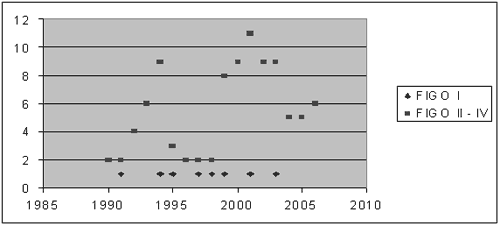|
|
|||||||||||||||||||||||||||||||||||||||||||||||||||||||||||||||||||||||||||||||||||||||||||||||||||||||||||
| UDK 618.11-006(497.11)"1990/2006" | ISSN 0350-2899, 33(2008) br.1-2 p.34-36 | ||||||||||||||||||||||||||||||||||||||||||||||||||||||||||||||||||||||||||||||||||||||||||||||||||||||||||
| Original paper Ovarian cancer - forthcoming diseaseLjubica Milošević(1), Tihomir Kostić(2), Dragoslav Kalinović(1),
Jasmina Diković(3) |
|||||||||||||||||||||||||||||||||||||||||||||||||||||||||||||||||||||||||||||||||||||||||||||||||||||||||||
|
|
|||||||||||||||||||||||||||||||||||||||||||||||||||||||||||||||||||||||||||||||||||||||||||||||||||||||||||
| Summary: In our country this disease has a morbidity incidence of 1.3 – 12 in 100,000 women and with a mortality rate of 0.7 – 8.6 in 100,000 women, with a constant increasing tendency. At the Gynaecology and Obstetrics Department of the Health Care Centre in Zaječar a retroactive survey covering the period 1990–2006 was made. Preoperative diagnosis, operative protocols and HP verification were examined as well as the disease stadium according to FIGO classification and women’s ages. In the period 1990–1999, 46 women had surgery, of which 6 (13,04%) were in FIGO I stadium and 40 (86,96%) were FIGO II and higher. In the second observed period 2000–2006, 56 women had surgery – 2 patients were FIGO I (3.57%) and 54 women were FIGO II and higher (96.43%). In the last decade of the 20th century an average surgical treatment of this disease was 4,6 women a year, but in the first seven years of this century there have been 8 such women. Key words: ovarian cancer, morbidity, mortality, stadium of disease Napomena: tekst rada na srpskom jeziku Note: text in Serbian |
|||||||||||||||||||||||||||||||||||||||||||||||||||||||||||||||||||||||||||||||||||||||||||||||||||||||||||
INTRODUCTIONThe most common type of peculiarities on the ovary are tumours – benign
or malign (1). The ovary cancers are the third most frequent (2), third
only to the cancer of the cervix and endometrium, with tendency to
become more frequent (3). A yearly incidence in the word is 5 to 10 out
of 100.000 women (4). In our region, this disease has the morbidity
incidence of 1.3 – 12 out of 100.000 women and the mortality rate of 0.7
– 8.6 out of 100.000 women, being in constant increase (5, 6). Out of
all malignity cases at women, 20 – 26% are in the reproductive female
organs, out of which 5% are the ovary cancer (7). The tendency of
increase occurs in the menopause period. DISCUSSIONBecause of the wide anatomic origin of the cells, found in the ovary
epithelium and stroma, and being omnipotent, there are many types of the
ovary cancer. Late diagnosis, causing poor results of treatment, imposes
the imperative for pursuing the way for early diagnosis of this disease.
Today, however, there are still no possibilities for real screening
diagnosis. The tumour markers, specific for the ovary, that are used
today, do not have practical application in the early phase of the
disease (3), as well as the US vagina examination (including the colour
Doppler of the ovary blood vessels) and the bimanual gynaecological
examination (8). In 70% of the cases in the world (9. 10) and in 75% in
Serbia (7), the disease is diagnosed when there have been developed the
intra-abdominal metastasis.. |
|||||||||||||||||||||||||||||||||||||||||||||||||||||||||||||||||||||||||||||||||||||||||||||||||||||||||||
Table 1. Pre-operative
diagnoses
|
|||||||||||||||||||||||||||||||||||||||||||||||||||||||||||||||||||||||||||||||||||||||||||||||||||||||||||
| Prominent biological
aggressiveness of the ovary malignity and late diagnosis are the causes
for poor result of treatment. Referring our data, in the period from 1990 to 2006, in the early phase of the disease, 8 women (8.15%) were treated, while in the later phase, 94 women (91.49%), the fact explained by closed environment, poor socioeconomic conditions of life and health ignorance. In the last decade of 20th century, 4.6 women were operated yearly, while in the first seven years of 21st century 8 women a year. CONCLUSIONConcerning the state in our country, the frequency rate of this disease
is in increase (4). Surveying the Operation Records and the Anamnesis on
the Gynaecology & Obstetrics Service and the Surgery Service of the
Health Center in Zajecar, it was retroactively analyzed the period of
time from the year 1990 to the year 2006. It was found out that, in the
period of time from 1990 to 1999, 46 women were operated, out of whom 6
(13.04%) in the FIGO I stage, and 40 (86.96%) in the FIGO II stage and
later in the disease. In the second analyzed period from the year 2000
to 2006, 56 women having the ovary cancer were operated, out of whom 2
(3.57%) in the FIGO I stage, while 54 (96.43%) in the FIGO II stage and
later. In the last decade of 20th century, 4.6 women were operated in a
year, while in the first seven years of the 21st century, 8 women a
year. The spread of this disease is, compared to the cervix and
endometrium cancer exceptionally fast. That is why the diagnosing of
this disease is in 75% cases and more occurs in the late stage. The
number of diagnosed and HP confirmed ovary cancer in the last decade of
20th century is less than the firs seven years of 21st century, proving
the fact that the ovary cancer disease is in increase. REFERENCES
|
|||||||||||||||||||||||||||||||||||||||||||||||||||||||||||||||||||||||||||||||||||||||||||||||||||||||||||
|
Corresponding Address: Ljubica Milošević Health Centre Zaječar Gynaecology & Obstetrics Ward e-mail: dumil019@ptt.yu Paper received: 18.3.2008 Paper accepted: 23.7.2008 Published online: 20.10.2008 |
|||||||||||||||||||||||||||||||||||||||||||||||||||||||||||||||||||||||||||||||||||||||||||||||||||||||||||
|
|
|||||||||||||||||||||||||||||||||||||||||||||||||||||||||||||||||||||||||||||||||||||||||||||||||||||||||||
| Infotrend Crea(c)tive Design | |||||||||||||||||||||||||||||||||||||||||||||||||||||||||||||||||||||||||||||||||||||||||||||||||||||||||||

